SILVANA MOSSANO
Reportage udienza 29 settembre 2021
Ma come faceva un imprenditore del livello di Stephan Schmidheiny, alla testa di un gruppo che contava diverse società in più Stati, come faceva a sapere che cosa succedeva nello stabilimento di Casale Monferrato? E’ uno degli aspetti su cui si è concentrato l’avvocato Astolfo Di Amato (che, con il collega Guido Carlo Alleva, difende l’imprenditore svizzero nel processo «Eternit Bis», in Assise a Novara) durante il «controesame» del consulente della procura Paolo Rivella che si è svolto ieri mattina, mercoledì 29 settembre, davanti alla Corte presieduta da Gianfranco Pezone (affiancato da Manuela Massino e dai giudici popolari).
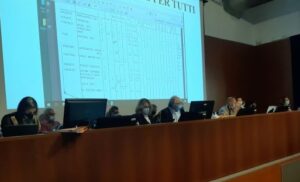
Rivella, lunedì, aveva parlato sei ore per illustrare il ruolo degli Schmidheiny nella conduzione delle loro aziende (settori del cemento e dell’amianto). Dal 1976 è Stephan che ha in capo la gestione dell’amianto, al fratello Thomas il padre Max ha lasciato invece le fabbriche di cemento. E il consulente, incaricato dai pubblici ministeri Gianfranco Colace e Mariagiovanna Compare, aveva concluso con un’affermazione inequivocabile: «Gli Schmidheiny erano i padroni».
Il difensore ha cercato di scardinare questa convinzione, mettendo in dubbio che un imprenditore con una tale galassia di società potesse essere a conoscenza di quanto avveniva nella fabbrica casalese, che non si sa bene se avesse mai visto; qualcuno disse che forse una volta vi si era recato, non se ne ha prova certa. Rivella, alla passata udienza, aveva mostrato una lettera in cui si preannunciava la visita di alcuni tecnici a Casale e, tra i nomi indicati, c’era quello di un tal Stephan Schmidheiny.
A proposito, quante erano le società che facevano parte del gruppo svizzero? Lo ha domandato l’avvocato Elisa Surbone che, ieri, sostituiva il collega Alleva. E Rivella: «Mittelholzer, che era un alto dirigente degli Schmidheiny, aveva indicato come ordine di grandezza un migliaio di aziende, prima che fossero suddivisi tra i due fratelli i comparti cemento e amianto».
Ma torniamo al ruolo di Stephan, perché è la sua posizione che conta in questo processo, in quanto deve difendersi dall’accusa di omicidio volontario, con dolo eventuale, di 392 casalesi morti a causa dell’amianto.
CHI COMANDAVA?
L’avvocato Di Amato vuole puntualizzare, rileva contraddizioni e imprecisioni: solleva il dubbio che un solo uomo potesse avere tutta la situazione sotto mano e ipotizza che la gestione, più concretamente, fosse invece affidata a dirigenti e manager di vario livello, secondo un ordine gerarchico.
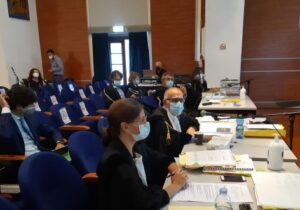
«Certo che sì – ha detto Rivella -, Stephan Schmidheiny ha sempre gestito avvalendosi di dirigenti, uomini di stretta fiducia, formati in Svizzera (anche con test psicologici effettuati là), nominati da lui e che rispondevano direttamente a lui». Un esempio? «Luigi Giannitrapani, amministratore delegato di Eternit spa, il numero uno in Italia, con cui intratteneva una corrispondenza riservata, depositata in una casella postale specifica a Genova». Di Amato osserva che quelli erano gli anni delle Brigate Rosse e, forse, era semplicemente una precauzione per salvaguardare la corrispondenza. «Sì, ma allora avrebbe dovuto valere per tutta la corrispondenza e non solo per quella» chiosa Rivella.
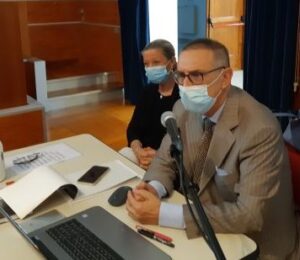
Il consulente insiste: «Il controllo degli svizzeri (anche i predecessori di Stephan, il padre Max e lo zio Ernst, ndr) era più pervasivo di quello esercitato dai belgi Emsens. E Stephan Schmidheiny gestisce il più possibile in maniera diretta, pur affidando deleghe a dei dirigenti che erano scelti personalmente da lui. In lui si concentrava in concreto la proprietà e la gestione: una figura molto simile a quella che in Italia viene concepita come padrone».
INVESTIMENTI E CONCORRENZA
L’avvocato Di Amato ha poi approfondito il tema dell’investimento fatto dal gruppo svizzero con l’acquisizione di Eternit spa italiana, nel 1972, mentre i belgi si erano sfilati perché non la ritenevano più una fonte di guadagno. Ha contestato a Rivella una contraddizione: «Lei ha affermato che il gruppo svizzero ha acquisito Eternit in Italia per tenere a bada i concorrenti (di medio-alta grandezza come Sacelit, Fibronit, Italtubi e altri minori, ndr). Ma non aveva definito gli Schmidheiny imprenditori capaci e intraprendenti? Che paura potevano avere?». Il consulente ha spiegato che «gli svizzeri hanno effettivamente dato prova di non temere investimenti difficili: lo hanno dimostrato in Libia, in Egitto, in Libano, ad esempio. Avevano, è vero, meno paura del rischio-Paese rispetto ai belgi. Ma temevano i “piccoli” concorrenti in Italia, volevano tenerli a bada per non compromettere il monopolio». Ha incalzato Di Amato: «Ma di quale monopolio parliamo se, appunto, c’era in Italia una rosa di aziende di proprietari diversi!». Il consulente ha ribattuto: «No, no, era il monopolio in Europa che volevano tutelare, impedendo ai “piccoli” imprenditori dell’amianto italiani di varcare il confine e di dare fastidio alle loro aziende in Svizzera e in Germania».
ACQUISIZIONE AMIANTIFERA DI BALANGERO
Il gruppo svizzero, nel 1978, compra il cinquanta percento dell’Amiantifera Balangero, la società proprietaria dell’unica cava di amianto in Europa. Di Amato ha contestato il consulente: «Lei ha detto che, nei primi anni Settanta, si avverte che il settore dell’amianto è volto al declino, destinato a morire. E perché allora avrebbero investito denaro (dieci miliardi) per comprare l’Amiantifera di Balangero?». Il consulente ha replicato che «all’inizio del decennio, c’era effettivamente quella convinzione, ma nel 1977/78 hanno visto che il margine temporale di sopravvivenza era più lungo di quanto avessero stimato. E hanno deciso di mungere la mucca il più possibile. Avere l’unica cava di amianto d’Europa era un grande vantaggio rispetto ai concorrenti: nessun altro poteva disporre della materia prima, che è, tra l’altro, la più costosa rispetto ai materiali poveri della miscela, che sono cemento e acqua».
LA RICERCA
«L’Eternit spa in Italia aveva un centro di ricerca?» si è informato il difensore Di Amato. «No» ha ribadito il consulente. «E, allora, che c’è di strano che il riferimento fosse il laboratorio diretto dal medico scienziato Klaus Robock, a Neuss?».
Più che stano, Rivella ha evidenziato che «Robock non era solo un tecnico, ma un propagandista a favore dell’uso dell’amianto». A significare che in quella direzione orientava esperimenti e studi.
Il difensore non ha lasciato cadere la palla e ha incalzato: «Anche Irving Selikoff, nei primi anni Settanta, ha riconosciuto che non era da escludere un uso controllato dell’amianto, cioè utilizzato in condizioni di sicurezza». La domanda è effettivamente insidiosa. Rivella ha ricordato che, nel 1964, Selikoff aveva lanciato l’allarme mondiale: «L’amianto provoca il cancro e non soltanto a chi lo lavora», e per questa posizione era stato criticato, dileggiato ed emarginato. Ma poi? Poi, ha ammesso Rivella, nel tempo Selikoff ha modificato le sue opinioni iniziali; il consulente ha però suggerito la lettura del libro «Difendere l’indifendibile» (titolo originale «Defending the indefensible», di Jock McCullogh e Geoffrey Tweedale, edito da Oxford University Press), in cui viene esaminata anche la personalità di Selikoff nella parte più avanzata della sua esistenza.
INVESTIMENTI IN SICUREZZA
Di Amato ha citato cifre spese in Italia: «Come si fa a dire che non sono state investite in sicurezza?». Il consulente (che aveva quantificato in poco meno di 4 miliardi di lire quegli importi dedicati alla sicurezza, pur non dettagliati e non tutti riconducibili a puntuali interventi) ha ribadito: «Non c’è una voce specifica nei bilanci». La risposta non soddisfa del tutto il difensore: «Era obbligatorio indicare le cifre riferite agli interventi sulla sicurezza nei bilanci?». Rivella ammette che all’epoca no, «ma, per trasparenza, se uno li spende quei soldi li annota». E, poi, ha aggiunto: «Ho visto che Eternit ha fatto sì uno sforzo per misurare la polverosità e le fibre, ma uno sforzo per limitarle, le fibre, non l’ho riscontrato».
Tra l’altro, nei quattro milioni scarsi, «era inclusa anche la spesa per il depuratore delle acque, e quindi non tutta quella cifra era stata spesa per bonificare l’aria». Non solo, il consulente ha mostrato anche un documento significativo: cioè il prospetto messo a punto dagli ispettori del Lavoro (quindi pubblici ufficiali) che, nell’87, dopo il fallimento, avevano raccolto elementi utili alle indagini e avevano riferito che «a quanto la ditta ci dice, tra il 1975 e il 1980 sono stati spesi poco più di un milione e 600 mila euro per il miglioramento della qualità dell’aria all’Eternit».
NEUSS E AULS 76
Di Amato vuole definire il ruolo e gli intenti espressi dall’imprenditore svizzero nel convegno di Neuss, in Germania, cui aveva convocato i suoi massimi dirigenti a giugno 1976. «Ha evidenziato i rischi per la salute e ha prospettato un “risanamento delle aziende con provvedimenti tecnici e l’effettuazione di controlli”. E’ scritto nei verbali. E ha anche detto che i lavori andavano eseguiti senza tanto scalpore ma con energia. Le sembra il comportamento di un imprenditore che si disinteressa dei rischi paventati?».
Per Rivella l’interpretazione è questa: «Schmidheiny ha pronunciato parole positive, ma c’è contraddizione tra quel che ha detto e quel che ha fatto. Solo cinque mesi dopo, al seminario di Ermadingen, è uscito il manuale Auls 76, tutto incentrato a fornire indicazioni mirate a nascondere o minimizzare la pericolosità dell’amianto a chi avesse fatto domande in merito».
MANUALE BELLODI
E Guido Bellodi, a capo della società di pubbliche relazioni milanese, cui Schmidheiny si rivolse dall’84 (e di cui si servì almeno fino al 2005, per quel che si sa), che ruolo strategico avrebbe avuto? Secondo il difensore DI Amato non è poi una cosa così strana che l’imprenditore svizzero vi si fosse affidato: «Fallisce una società di una famiglia imprenditoriale importantissima (la Eternit spa italiana nell’84 era finita in amministrazione controllata ed era fallita nel 1986, ndr), e si apre pure un procedimento penale. E’ consueto che accada in altri Paesi?» si informa l’avvocato. No, in altri Paesi i processi penali per vicende come queste non si fanno («e infatti l’Italia viene guardata come esempio» ha sottolineato Rivella); si sono fatte, invece, cause civili con ingenti risarcimenti.
«Quindi – riprende Di Amato – c’è in Italia una causa penale e, in più, sono gli anni di “Mani pulite”. Tutto questo non può giustificare il ricorso a Bellodi?».
La risposta viene stoppata dal presidente della Corte, non è tema su cui il consulente è tenuto a esprimersi.
Riprende il difensore: «Bellodi ha suggerito una strategia di basso profilo: che cosa ha fatto, in particolare?». Rivella spiega che «ha messo sul territorio una serie di persone che raccogliessero segretamente informazioni su quel che si stava muovendo nei confronti di Eternit a livello politico, sindacale, di cittadinanza». Incalza il difensore: «Di fatto si è limitato a stare zitto. E che male c’è?».
Zitto nel senso che non ha parlato sì, però ha scritto: «Nel famoso Manuale Bellodi che viene chiamato la “Bibbia” – ha spiegato il consulente – sono messe nero su bianco le risposte che erano da dare affinché la vicenda rimanesse rigorosamente circoscritta all’ambito locale e si concedessero solo riferimenti a dirigenti locali, che facevano da barriera».
Era da scongiurare assolutamente che l’interesse e la curiosità sconfinassero a quelli indicati come livelli 3 e 4: cioè le società svizzere di vertice e, più di tutto, il nome di Stephan Schmidheiny.
SOCIETA’ SVIZZERA BECON
A proposito di società, il pm Colace ha richiamato la Becon, già citata alla passata udienza dal consulente. «Chi è la Becon?» ha domandato. «E’ il contenitore di tutta l’eredità dell’amianto». Colace: «La stessa società che stipula le transazioni con i cittadini?». E Rivella: «Sì, la Becon è la società di Schmidheiny. Sulle transazioni non c’è la firma di Stephan Schmidheiny, ma si risarciscono le vittime citate nel processo in cui Schmidheiny è l’imputato».
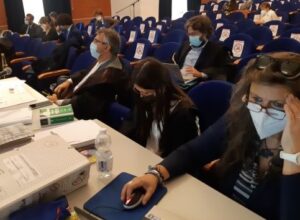
PROSSIMA UDIENZA
Lunedì 4 ottobre, sarà esaminato un altro consulente citato dalla procura: Luca Mingozzi, tecnico della prevenzione di Arpa.
Traduzione a cura di Vicky Franzinetti
SILVANA MOSSANO
September 29th 2021 Hearing
Defence lawyer Astolfo Di Amato (who, with his colleague Guido Carlo Alleva, defends the Swiss businessman in the trial “Eternit Bis”, in the Court of Assizes in Novara) asked how did a businessman of Stephan Schmidheiny’s stature, at the head of a group with several companies in several countries, know what was going on at the Casale Monferrato plant? This is one of the questions the defence asked in the cross of the Public Prosecutors’ expert, Paolo Rivella, yesterday morning, Wednesday, September the 29th , in the Court presided by Judge Gianfranco Pezone (with Judge Manuela Massino and the Jury aka popular judges).
On Monday, Rivella had spoken for six hours to illustrate the role of the Schmidheinys in managing their (cement and asbestos) companies. Since 1976, Stephan had been in charge of asbestos, while his brother Thomas was left in charge of the cement factories by his father Max. The expert for prosecutors Gianfranco Colace and Mariagiovanna Compare, concluded with an clear statement: “The Schmidheinys were the bosses”.
The defence lawyer tried to undermine the prosecutors’ expert, questioning whether a businessman with such a galaxy of companies could have been aware of what was going on in the Casalese plant, not knowing whether he had ever seen it; someone said that perhaps he had been there once, but there is no certain proof. At the last hearing, Rivella had shown a letter announcing the visit of some technicians to Casale and, among the names mentioned, Stephan Schmidheiny’s.
How many plants were part of the Swiss group asked the lawyer Elisa Surbone who replacing her colleague Alleva. Rivella: “Mittelholzer, who was a senior executive of Schmidheiny, had indicated roughly a thousand companies, before the cement and asbestos sectors were divided between the two brothers”.
Let’s go back to Stephan’s role, because it is his position that counts in this trial, as he has to defend himself against the charge of wilful murder, with of the 392 people from Casale who died from asbestos.
WHO WAS IN CHARGE?
Lawyer Di Amato tried to point out contradictions and inaccuracies: he raised the doubt that one man could have had the whole situation under control and suggested that it was instead entrusted to executives and managers of various levels, according to their role in the company hierarchy.
“Stephan Schmidheiny had always managed the company using managers, men he trusted, trained in Switzerland (even with psychological tests carried out there), appointed by him and who answered directly to him. An example? ‘Luigi Giannitrapani, managing director of Eternit spa, the number one in Italy, with whom he had a confidential correspondence, deposited in a specific post box in Genoa’. Di Amato notes that those were the years of the Red Brigades and, perhaps, it was simply a precaution to safeguard the correspondence. “Yes, but then it should have applied to all correspondence and not just that,’ Rivella concluded. And continued: ‘The control of the Swiss (including Stephan’s predecessors, his father Max and uncle Ernst, ed.) was more pervasive than that exercised by the Belgian Emsens. Stephan Schmidheiny managed as much as possible himself, even though he delegated some to managers who were personally chosen by him. Ownership and management were concentrated in him: a figure very close to the one conceived in Italy as an owner- boss.
INVESTMENTS AND COMPETITION
Mr Di Amato then went on to discuss the investment made by the Swiss group in the acquisition of the Italian company Eternit in 1972, while the Belgians had pulled out because they no longer considered it profitable. He challenged Rivella: “You said that the Swiss group acquired Eternit in Italy to keep competitors at bay (medium to large ones such as Sacelit, Fibronit, Italtubi and other smaller ones). But hadn’t you said the Schmidheinys were capable and enterprising entrepreneurs? Why would they have been afraid?”. The consultant explained that ‘the Swiss had indeed shown that they were not afraid of difficult investments: they proved it in Libya, Egypt, Lebanon, for example. True, they were less afraid of country risk than the Belgians. But they were afraid of the ‘small’ competitors in Italy, and wanted to keep them at bay so as not to compromise their monopoly’. Di Amato challenged: ‘But what kind of monopoly are we talking about if, in fact, there were a number of companies with different owners in Italy! Rivella replied: “No, no, it was the monopoly in Europe that they wanted to protect, preventing the “small” Italian asbestos entrepreneurs from crossing the border and bothering their companies in Switzerland and Germany“.
BALANGERO ASBESTOS TAKEOVER
In 1978, the Swiss group bought fifty per cent of Amiantifera Balangero, the company that owned the only asbestos mine in Europe. Di Amato challenged the consultant: “You said that, in the early Nineteen Seventies, they felt that the asbestos sector was heading for decline, deemed to die. So why then would they have invested money (ten billion) to buy the Amiantifera Mine in Balangero?”. The consultant replied that ‘at the beginning of the decade, that is what they believed, but by 1977/78 they saw that their time horizon was longer than previously estimated. So they decided to get all they could. Owning the only asbestos quarry in Europe was a big advantage over competitors: no one else could get the raw material, which is, by the way, the most expensive compared to the poorer materials in the mix, which are cement and water.”
RESEARCH
“Did Eternit spa in Italy have a research centre?” inquired defence counsel Di Amato. “ No,” reiterated the consultant. “And, then, what’s strange about the reference being the laboratory directed by the medical scientist Klaus Robock, in Neuss?”
More than strange, Rivella pointed out that “Robock was not only an expert, but a propagandist in favour of the use of asbestos”. This meant that he was steering experiments and studies to cover up for asbestos related illnesses.
The defence lawyer pressed on: “In the early Seventies, even Irving Selikoff recognised that a controlled use of asbestos, i.e. used under safe conditions, was not to be excluded“. The question is indeed a tricky one. Rivella recalled that, in 1964, Selikoff had sounded the worldwide alarm: ‘Asbestos causes cancer, and not only in those who work with it’, he had been criticised, mocked and marginalised and for his position. But then what? Then, Rivella admitted, Selikoff changed his initial opinions over time; however, the consultant suggested reading the book “Defending the indefensible”, by Jock McCullogh and Geoffrey Tweedale, published by Oxford University Press, where Selikoff’s personality is also examined in the later part of his life.
HEALTH AND SAFETY INVESTMENTS
Di Amato quoted the amounts spent in Italy: “How can you say that they did not invest in safety?”. Rivella, who had quantified the sums for health and safety at just under 4 billion lire (under 2 million Euros), although not detailed and not all of which could be attributed to specific interventions reiterated: “There was no specific item in the budgets“. The defence lawyer was not entirely satisfied with the answer: ‘Was it compulsory to indicate the figures for safety measures in the budgets? Rivella admitted that at the time it was not, ‘but, for the sake of transparency, if you spend the money, you should write it down’. He added: “I saw that Eternit made an effort to measure dust and fibres, but I did not see any effort to limit fibres.
NEUSS AND AULS 76
Defence lawyer Di Amato wanted to define the Swiss entrepreneur’s role and intentions expressed at the Neuss conference, in Germany, where he had summoned his top executives in June 1976. “He highlighted the health risks and proposed a “rehabilitation of the companies with technical measures and the implementation of controls“. This was written in the minutes. And he also said that the work had to be carried out with energy and without a lot of fuss. Does that sound like the behaviour of a businessman who does not care about the risks involved?
For Rivella, the interpretation is this: ‘Schmidheiny spoke nice words, but there is a contradiction between what he said and what he did. Only five months later, at the Ermadingen seminar, the Auls 76 manual came out, all of which focused on providing indications aimed at hiding or minimising the dangers of asbestos to those who asked questions about it’.
BELLODI MANUAL
Guido Bellodi, head of the Milanese public relations company, which Schmidheiny turned to in 1984 (and which he used at least until 2005, as far as we know), what was his strategic role? According to the defence lawyer Di Amato, it is not so strange that the Swiss entrepreneur had relied on them: “A company belonging to a very important business family goes bankrupt[1], and criminal proceedings start. Is this usual in other countries?” the lawyer asks. No, in other countries criminal proceedings for events like these are not carried out (‘and in fact Italy is looked at as an example’ Rivella reiterates); instead, civil lawsuits with huge compensation are carried out.
“So,’ Di Amato resumes, ‘there is a criminal case in Italy and, in addition, these are the years of “Mani pulite[2]“. Can’t all this justify resorting to Bellodi?”.
The answer is stopped by the President of the Court, it is not a subject on which the consultant is required to express himself.
The defence counsel resumed: “Bellodi suggested a low-profile strategy: what did he do, in particular?”. Rivella explained that “he placed a series of people in the area to secretly gather information on what was happening against Eternit at the political, trade union, and community level“. The defence urged: “In fact, he just kept quiet. And what’s wrong with that?”.
Quiet in the sense that he did not speak, yes, but he wrote: “In the famous Bellodi Manual, which is known as the ‘Bible’, – explained Rivella – are in black and white responses that were to be given so that the story remained strictly confined to the local area and only references to local leaders, who acted as a barrier.
It was imperative to prevent interest and curiosity from encroaching on those indicated as levels 3 and 4: i.e. top Swiss companies and, above all, the name of Stephan Schmidheiny.
The SWISS BECON COMPANY
Speaking of companies, the Prosecutor Colace recalled Becon, already mentioned at the last hearing by the consultant. “What was Becon?” he asked. “It was the container for the whole asbestos legacy.” Colace: “The same company that enters into transactions with citizens?” Rivella: ‘Yes, Becon is Schmidheiny’s company. Stephan Schmidheiny’s signature is not on the transactions, but the victims named in the trial in which Schmidheiny is the defendant are compensated.
NEXT HEARING
On Monday, 4 October, another Prosecution consultant: Luca Mingozzi, prevention technician of Arpa (Environmental Agency) .
Lawyer D’Amico’s office (Lawyer G. Mattalia)
At today’s hearing the defence lawyer cross examined Dr. Rivella. The defence’s questions were mainly aimed at undermining the consultant in the part of his testimony where he claimed that the investments in health safety made by the Swiss group (which managed the Eternit plants in Italy) were in fact much lower than stated, especially as regards dust abatement and plant modernisation. The defence lawyers then tried to downplay the defendant’s role in the management of the plants in Italy, arguing that Schmidheiny was actually a very high-level managerial figure who dealt with the group’s industrial policies and could not have known the local situation of each plant.
“At the hearing of 27 September, Dr Paolo Rivella, a Public Prosecutor’s expert witness, was heard. The consultant reconstructed in detail the corporate events of the companies that managed the Eternit plant in Casale Monferrato over the years, and then went on to examine the cartel of industries that dealt worldwide with the production and trade of asbestos-cement products and the role of Eternit within the cartel itself. Dr. Rivella then examined in depth the relationship between Eternit Italy and Eternit Switzerland, headed by the Schmidheiny family, and in particular Stephan Ernst Schmidheiny, the current defendant.
The final part of the expert’s direct was devoted to the activities promoted by the defendant after the closure of the plant, aimed at monitoring the initiatives of trade unions, associations, lawyers and even magistrates concerning the case of environmental pollution by asbestos fibres in the territory of Casale Monferrato.
[1] Eternit SpA in Italy in 1984 went into receivership and went bankrupt in 1986,
[2] https://en.wikipedia.org/wiki/Mani_pulite

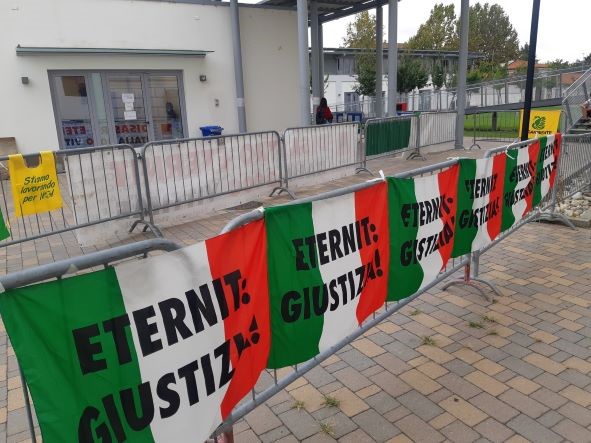
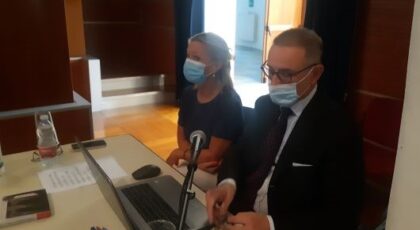
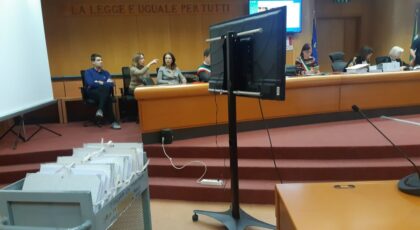
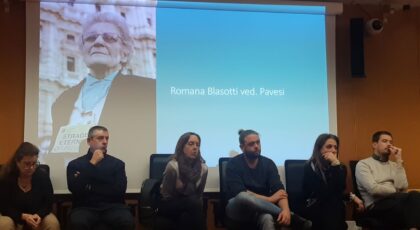
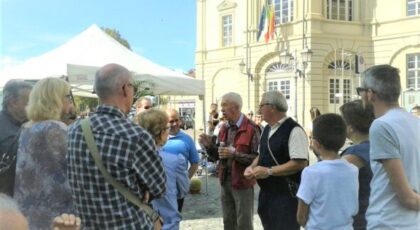
Sempre grazie e sempre cose nuove e purtroppo tragiche. Seguiamo con apprensione nella speranza che trionfi la GIUSTIZIA soprattutto per onorare e ricordare chi non è più tra noi.
Grazie Silvana, permetti a noi… Che siamo fuori, di ricostruire fatti, momenti, episodi, tasselli mancanti alla nostra memoria….